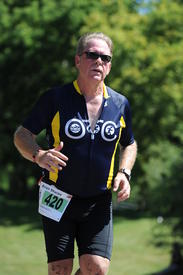Runners....shorten your stride?

BrianSharpe
Posts: 9,247 Member
Interesting article in Runners World supporting shortening your stride.
http://news.runnersworld.com/2012/04/14/more-evidence-favoring-shorter-stride/?cm_mmc=NL-TrainingExtra-_-887032-_-04242012-_-A-Shorter-Stride?
http://news.runnersworld.com/2012/04/14/more-evidence-favoring-shorter-stride/?cm_mmc=NL-TrainingExtra-_-887032-_-04242012-_-A-Shorter-Stride?
0
Replies
-
You have to be careful about overgeneralizing the results of one study, esp one in which the pace studied was 10:45 per mile.
There are several issues in play when determining stride length. One is performance. There is an optimal stride length efficiency for each person, based on their anatomy--running at a stride shorter than this or longer than this increases oxygen uptake and thus is less efficient (you have to work harder to run the same speed). The body can adapt through training, but only a small to modest amount. The inefficiency "penalty" is definitely less at a shorter stride than for overstriding and a shorter stride is more "trainable", but people should still exercise caution about automatically trying to force themselves into an arbitrary cadence like 180 steps/min.
The second is injury. This is where a lot of the recent research has been done, like the study in this article. Research is showing that shorter strides reduce certain amounts of loading on the joints that MIGHT reduce the potential for injury. (I don't think I have seen any studies that have actually proven this--i.e. looked at two groups over time with different stride lengths and compared injury rates--it would be very difficult to do. But without those studies, a lot of this is speculation).
Third -- what is the person's natural awareness of their stride and running style. I made the argument once that everyone had their own natural style and should not try to artificially alter that on the basis of someone else's criteria. I got a number of replies that argued that, while that may be true, a large number of people were not aware enough of their body movement or running style to correctly "find" their form. So I had to concede that this might be the case.
To me, rather than artificially adopting a rigid set of cadence and stride-length "rules", it is better to learn to run with a more compact and controlled stride. The effect of the smaller stride is to keep your forward foot closer to your center of mass--that's the key element, not the stride rate or foot placement per se. That's just my personal preference--I don't see how it helps someone who already has less body awareness to just start counting steps. That may be one tool or an initial step to help them GAIN awareness, but IMO, it shouldn't be the end in itself.
There is not one "best" stride for everyone. Ideally, one is looking to find a stride that reduces the risk of impact injuries but does not have an adverse effect on performance.0 -
To me, rather than artificially adopting a rigid set of cadence and stride-length "rules", it is better to learn to run with a more compact and controlled stride. The effect of the smaller stride is to keep your forward foot closer to your center of mass--that's the key element, not the stride rate or foot placement per se. That's just my personal preference--I don't see how it helps someone who already has less body awareness to just start counting steps. That may be one tool or an initial step to help them GAIN awareness, but IMO, it shouldn't be the end in itself.
There is not one "best" stride for everyone. Ideally, one is looking to find a stride that reduces the risk of impact injuries but does not have an adverse effect on performance.
+1. And I totally cringed at that thread yesterday where people were advising the OP to take longer strides. I did that as a new runner...it landed me with an injured hip flexor.
Kids don't think about their stride and they run around all the time--without injury. Most runners would do better to stop overthinking things and just run.0 -
I have actually heard about this before a while back. From personal experience, I do both. On the treadmill, my strides are shorter due to the length of the treadmill. But when I am actually running a race, I definitely don't have a short stride. Thus, the reason why my times are faster outside than on the treadmill.
In my opinion, shorter strides (not sure how short) is probably better for those who are still working on their form. Build a foundation first, i guess.0 -
Stride is all about situation. Uphill is a different stride than downhill which can be different than running on a flat surface. It's all about minimizing injury possibilities. I have had to shorten my stride and increase my footsteps to get over my IT band issue and it has helped my knee pain dissipate too.0
-
Stride is all about situation. Uphill is a different stride than downhill which can be different than running on a flat surface.
Agreed0 -
Brian - thanks for posting the link. I have read a number of articles on shortening stride, and I have messed around with it a little and find it fairly uncomfortable. I think everyone does have a natural stride, especially if they have run for a number of years. I do completely agree with the physics of lowering the stride to minimize impact - I have tried to do this as well, and have been fairly successful.
Greg0 -
I think it's important to make the distinction between "stride length" and "cadence". These are too often assumed to be the same thing. I am guilty of saying "shorten your stride" instead of making an observation about cadence. The same cadence of 160 to 180 steps per minute will obviously produce different "stride lengths" at different paces. I think many beginning runners fail to make this distinction as well but with a twist, believing that they have to reach forward to lengthen their stride to get faster, when in reality, they just need to run more to become more efficient and to allow the speed to develop naturally (to a point. Yes, speed work of some sort will be necessary at some point in their development). Those types of queries are the ones that I always tell to go with a particular cadence. The reason being that it should help prevent them from heels striking and putting undo stress on their joints and to take their focus away from artificially lengthening their stride by reaching.0
This discussion has been closed.
Categories
- All Categories
- 1.4M Health, Wellness and Goals
- 398.1K Introduce Yourself
- 44.7K Getting Started
- 261K Health and Weight Loss
- 176.4K Food and Nutrition
- 47.7K Recipes
- 233K Fitness and Exercise
- 462 Sleep, Mindfulness and Overall Wellness
- 6.5K Goal: Maintaining Weight
- 8.7K Goal: Gaining Weight and Body Building
- 153.5K Motivation and Support
- 8.4K Challenges
- 1.4K Debate Club
- 96.5K Chit-Chat
- 2.6K Fun and Games
- 4.8K MyFitnessPal Information
- 12 News and Announcements
- 21 MyFitnessPal Academy
- 1.5K Feature Suggestions and Ideas
- 3.2K MyFitnessPal Tech Support Questions





